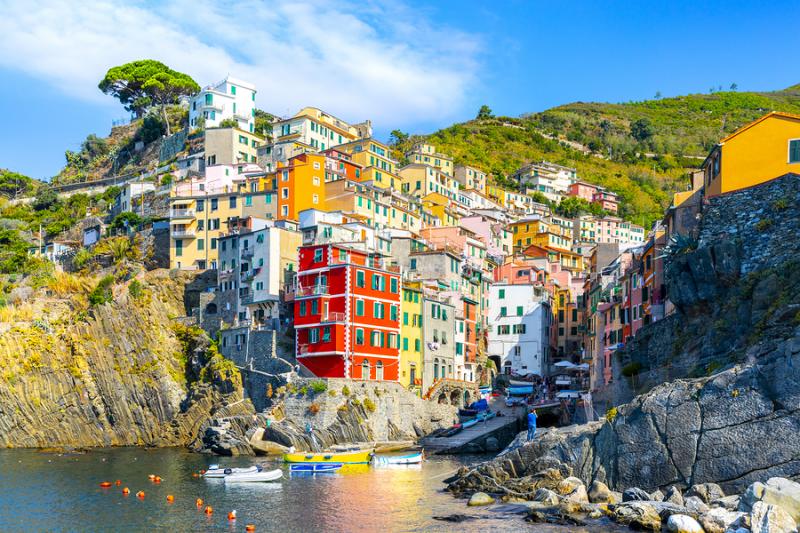UNESCO Sites of Italy: Portovenere, Cinque Terre and the Islands (Palmaria, Tino and Tinetto)
ITA:

Use player to listen to Italian version
Portovenere, Cinque Terre, and the Islands of Palmaria, Tino and Tinetto on the Ligurian coast were inscribed into the list of UNESCO’s World Heritage sites in 1997. According to UNESCO, this area, comprised between Levanto and La Spezia, is a cultural and scenic landscape of great value which exemplifies a balanced interaction between humans and nature and a way of life that has existed for a thousand years and continues to play an important social and economic role in the local community.
The steep and jagged coastal area of the Cinque Terre (the name by which the five villages of Monterosso, Vernazza, Corniglia, Manarola and Riomaggiore are known) has been cultivated for centuries, starting in the 12th century; dry stone walled terraces were built in order to be able to grow vines and olive trees. Cooperation between communities and a communal approach to farming have made such cultivations possible.
“The landscape and settlements as we know them today have come down to us thanks to the assiduity and perseverance over the years with which humans have constantly repaired the stone walls surrounding the cultivated fields in order to allow agriculture to flourish,” writes UNESCO.
The five villages that make up the Cinque Terre are a favorite tourist destination today, picturesque as they are, perched on the cliffs, crossed by narrow alleys between brightly colored houses.
The historic village of Portovenere dates from the 2nd century AD, when it was a port used by the Romans for routes to Gaul and Spain. It offers an unparalleled vista, with its houses aligned along the coast close to each other, the Doria Castle, a remarkable example of Genoese military architecture, and the Church of San Pietro, perched on a rock, built by the Genoese on the remains of an early Christian church.
Off the coast of Portovenere are the three islands of Palmaria, Tino and Tinetto, noteworthy not only for their natural beauty, but also for the many remains of early monastic establishments.
Portovenere, le Cinque Terre e le Isole di Palmaria, Tino e Tinetto sulla costa ligure sono state iscritte nell'elenco dei siti UNESCO patrimonio mondiale dell'umanità nel 1997. Secondo l'UNESO, questa zona, compresa tra Levanto e La Spezia, è un luogo culturale e paesaggistico di grande valore che esemplifica un'interazione equilibrata tra uomo e natura e un modo di vivere che esiste da mille anni e continua a svolgere un importante ruolo sociale ed economico nella comunità locale.
La costa scoscesa e frastagliata delle Cinque Terre (il nome collettivo con cui sono conosciuti i borghi di Monterosso, Vernazza, Corniglia, Manarola e Riomaggiore) è coltivata da secoli, a partire dal XII secolo; per poter coltivare viti e ulivi furono costruiti terrazzamenti sostenuti da muri a secco. La cooperazione tra le comunità del posto e un approccio comunitario all'agricoltura hanno reso possibili tali coltivazioni.
“Il paesaggio e gli insediamenti come li conosciamo oggi sono giunti fino a noi grazie all'assiduità e alla perseveranza con cui gli uomini hanno mantenuto negli anni i muretti a secco che circondano le coltivazioni per consentire all'agricoltura di prosperare”, scrive l'UNESCO.
I cinque villaggi che compongono le Cinque Terre sono oggi una meta turistica molto ambita, pittoreschi come sono, arroccati sulle scogliere e attraversati da stretti vicoli che si snodano fra case dai colori vivaci.
Lo storico villaggio di Portovenere risale al II secolo d.C., quando era un porto utilizzato dai romani per le rotte verso la Gallia e la Spagna. Offre una veduta impareggiabile, con le sue case allineate lungo la costa strette l'una all'altra, il Castello dei Doria, un notevole esempio di architettura militare genovese, e la Chiesa di San Pietro, arroccata su un'altura, costruita dai genovesi sui resti di un’antica chiesa cristiana.
Al largo di Portovenere si trovano le tre isole di Palmaria, Tino e Tinetto, degne di nota non solo per la loro bellezza naturale, ma anche per i numerosi resti di antichissimi monasteri.









